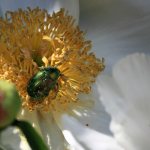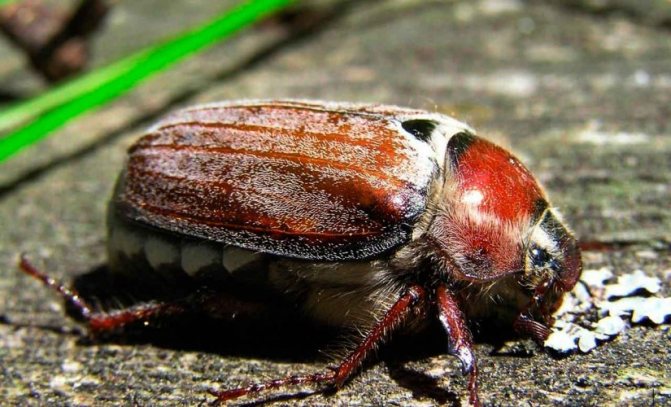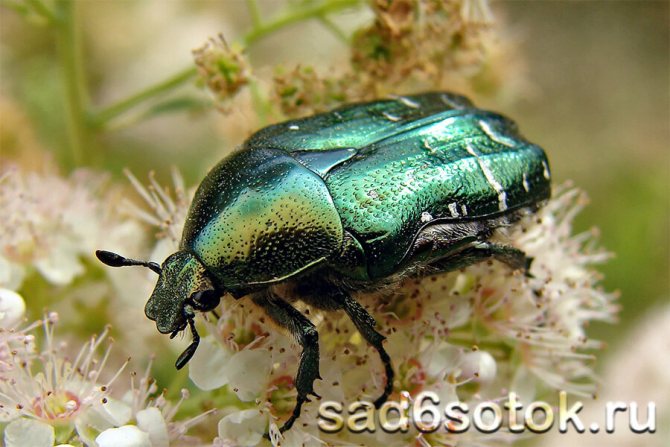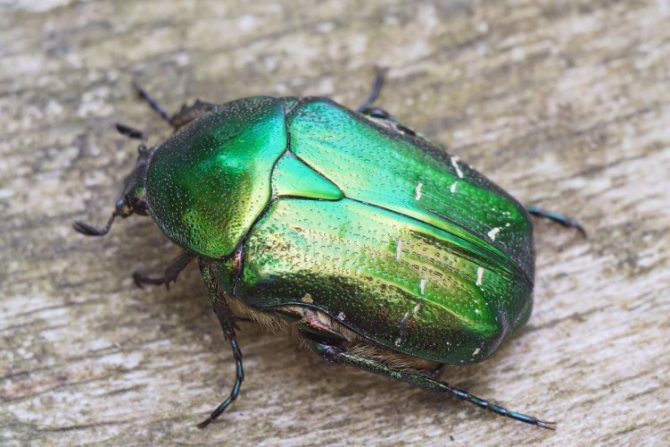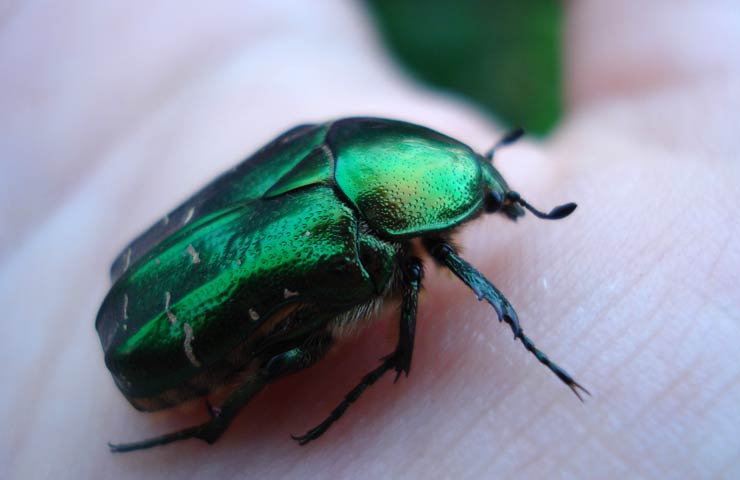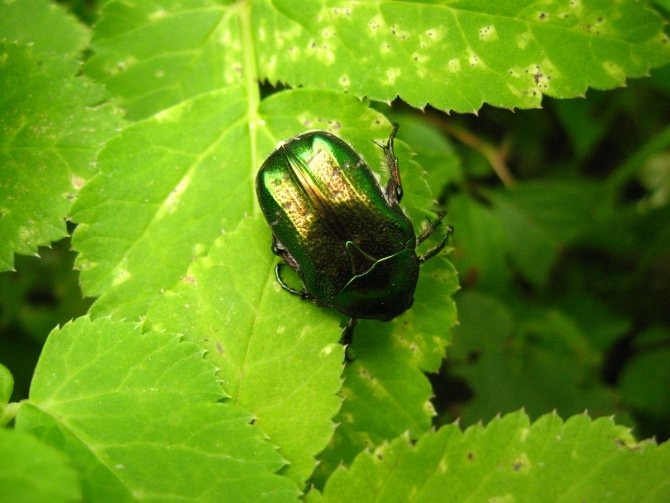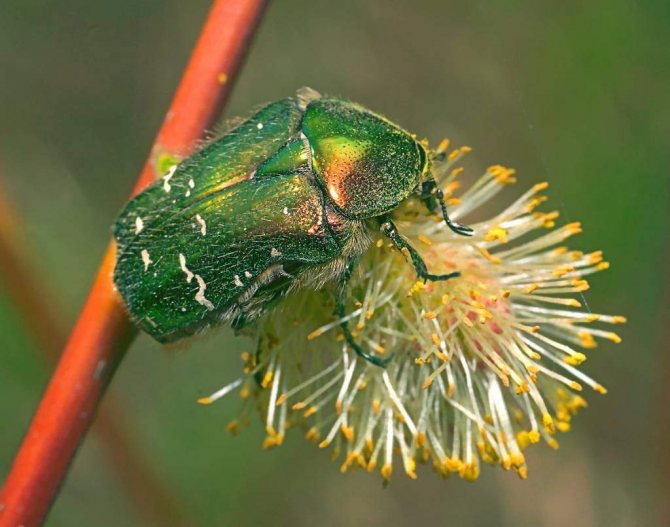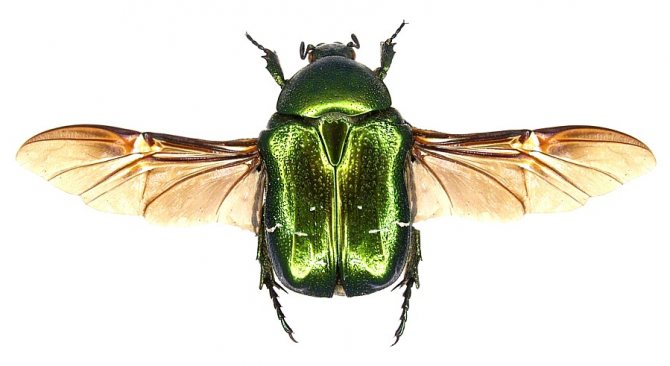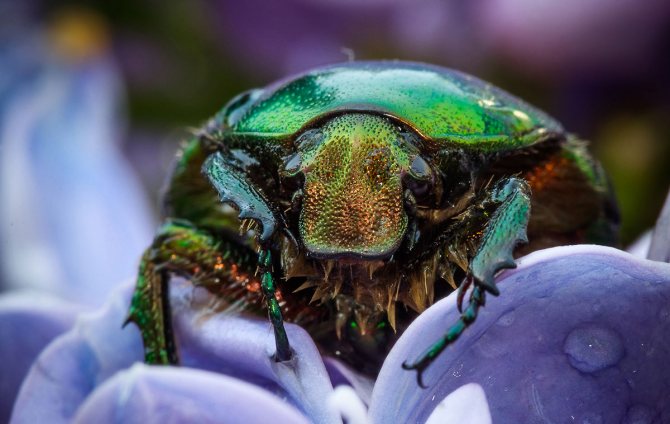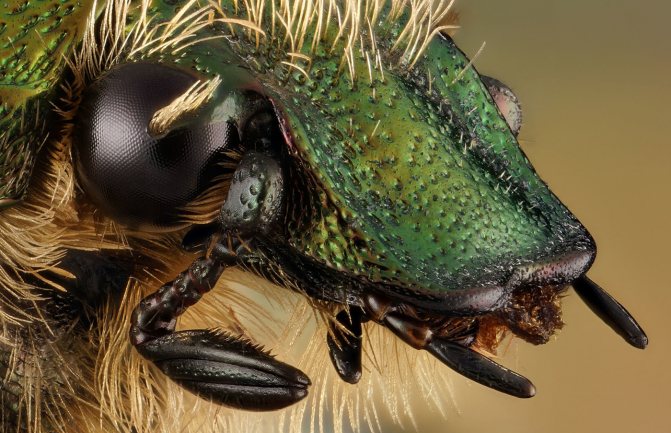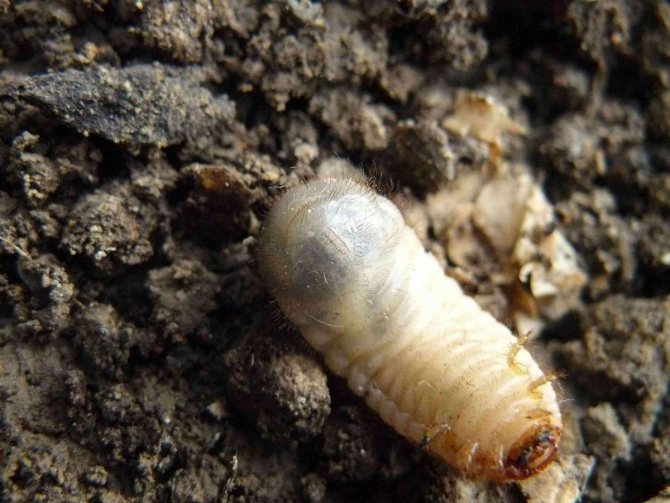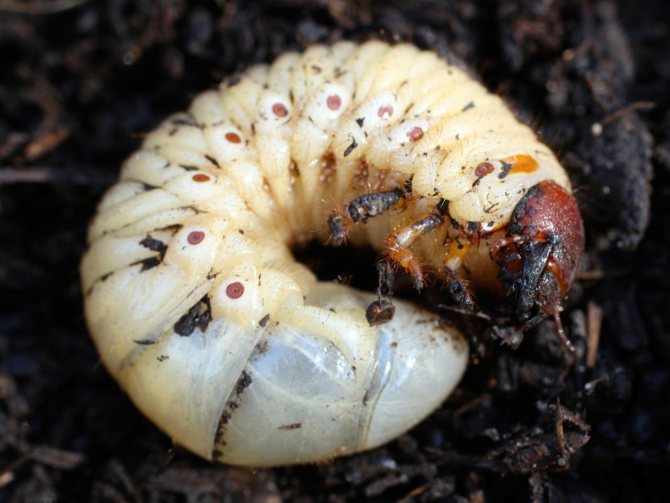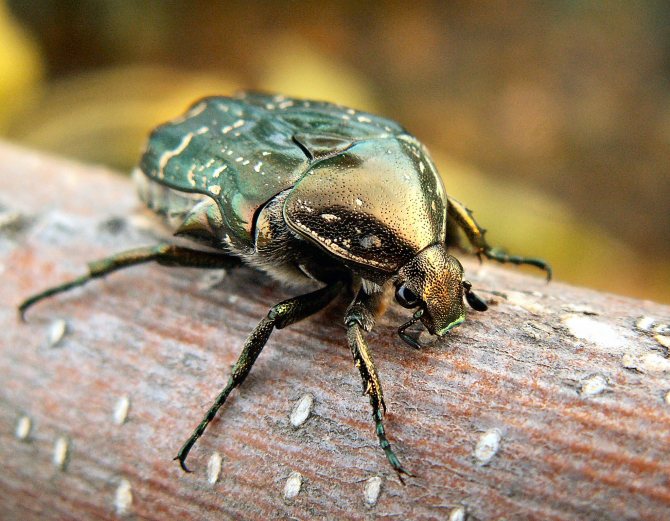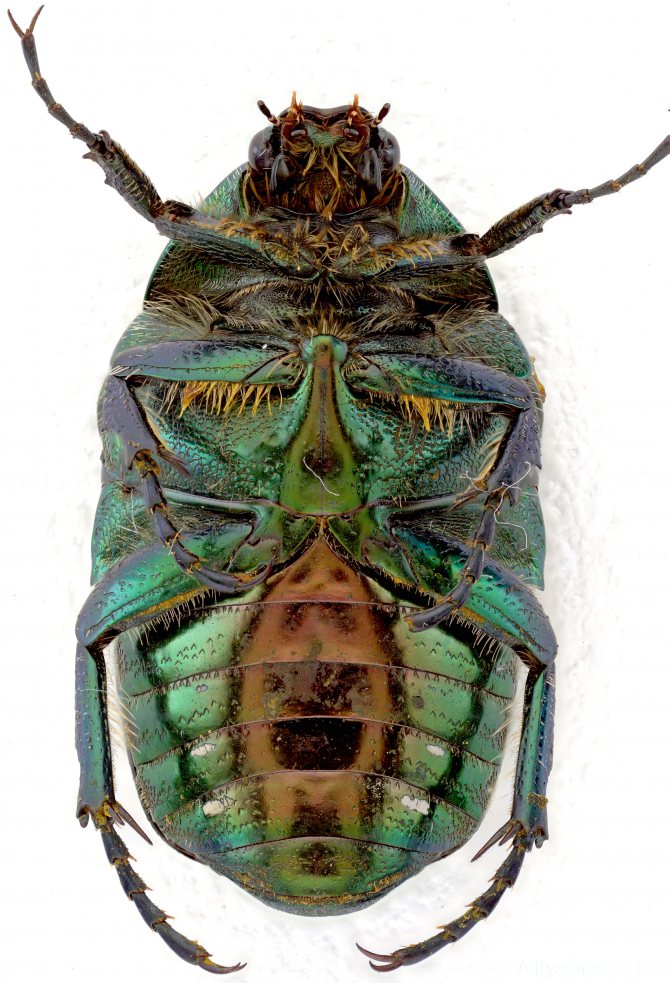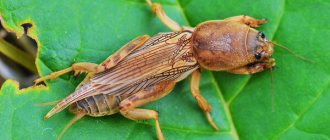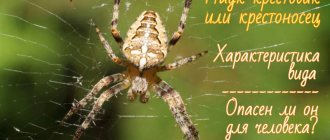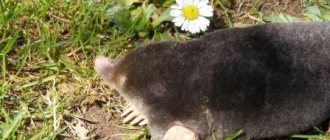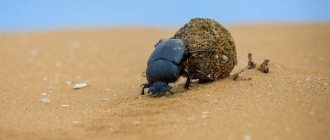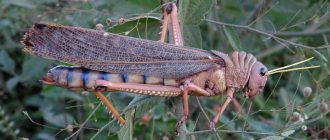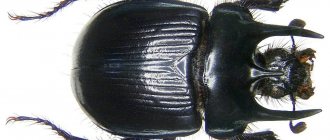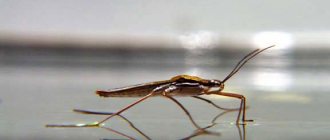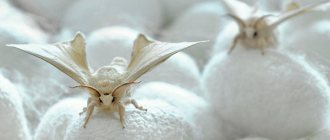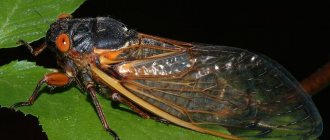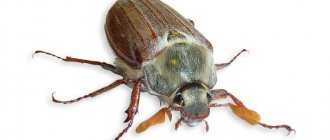What does a beetle look like?
You can see beetles on warm and sunny May or summer days, when many beautiful and fragrant plants bloom in gardens, on forest edges, meadows and glades. Insects fly from flower to flower, they are attracted by the smell of nectar.
Most bronzes are black, but due to the complex structure of the covers, light, falling on them, refracts and creates different shades, often with a metallic sheen. It can be green, blue, copper-red, purple, brown with a beautiful shine.
Bronze as a pest
Florists do not like bronzovki, since for them these beetles are deservedly a pest. I am annoyed when a blooming white lilac loses its luxurious inflorescences in just a couple of days. It is she who attracts the attention of large green beetles. They suck out all the juices from the flowers, leaving behind brown spots on the inflorescences. I got the impression that it is the white color that attracts the bronze. Such a conclusion can be made if you look at the lilac bushes of other colors growing nearby, compare the rose hips (white and pink-crimson) and peonies (very different). Of course, charming voracious beetles are not limited to white or very light flowers, but they are happy to savor them first of all.
Bronzes did not appear on our site immediately. They had nothing to do in a village in which blossoming gardens had not yet grown. From some point on, there were a lot of these emerald beetles. They turned into a pest. I know a lot of places in the Moscow region where there are practically no golden bronzes. Coincidence or not, but they know the May beetle well, which we do not meet.
The golden bronze flies perfectly, so there is no point in destroying it with the help of "chemistry". Methods for destroying bronzes are different for everyone. Some owners of plots of beetles crush them with their feet, others collect them and drown them in jars of water. Golden bronze flies into the open windows and doors of terraces and balconies, plop down with a crash on the windowsill or on the floor. Beetles quickly come to their senses and taste the taste of houseplants. The other day I took off the bronze from an orchid flower (phalaenopsis). Even here, the gourmet beetle did not change its taste preferences. He chose Phalaenopsis with white flowers! In recent years, alarming information has been appearing in the media more and more often that bronzes are willingly switching to ripe fruits, which, of course, does not please gardeners.
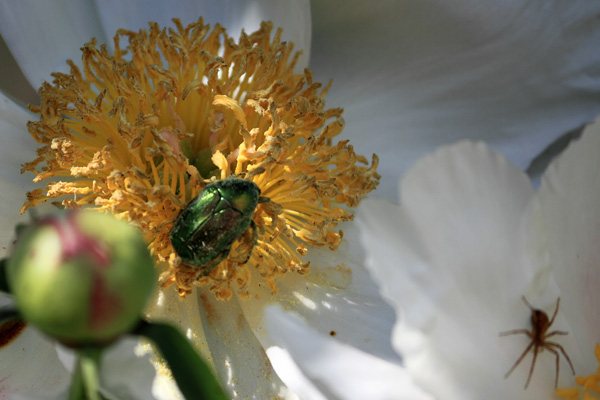
Description
Bronzovki - beetles with an oblong-oval and wide body and a small head, which is directed forward and lowered slightly downward. Depending on the species, the insect grows up to 8–30 mm in length. On the head of the insect there are black antennae, consisting of 10 segments, eyes and mouth apparatus. The dorsum is most often covered with hairs, but may be smooth.
The wings of the bronzes are well developed. Of the majority of lamellar beetles, they are distinguished by the presence of special cuts on the elytra. Through them, the insect releases its wings to rise into the air, while the elytra themselves remain tightly folded on the back.
Another feature of these insects are light scaly dots on the pronotum, chest, elytra, and legs. They come in different sizes, sometimes merging and covering most of the body.
The structure of the legs helps the beetles to dig the ground - there are teeth on the outer edges of the fore tibia.
Insect larvae are large, C-shaped - their body in the middle is expanded and curved like a hump. The covers are soft and translucent, white. The head capsule in the larvae is sclerotized and has 4 antennae.
Only some species of larvae have eyes. Legs are long, indistinctly segmented. There are no claws on the limbs. Bronze larvae can move on their backs.
Lifestyle
These insects are distributed throughout Eurasia, with the exception of mountains and certain areas, such as Northern Crimea, Portugal, Spain. Very often, a large green beetle is mistaken for a May beetle.
Both species have almost the same structure and lead a similar lifestyle. The insect feels most comfortable in a relatively humid climate. For this reason, they are not found in deserts.
Despite the unfavorable ecological situation in some regions, the population of the Common Bronze is not decreasing. The only exception is smooth. Any of the species differ in characteristic features:
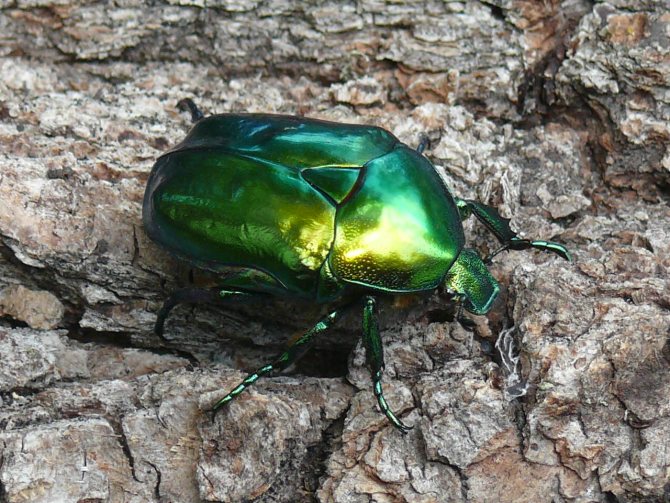

they start flying from May-June, making a flight for 3-4 hours;- maximum activity is observed during the hottest part of the day;
- they hide in the ground at night, and in cloudy weather they crawl out of shelters in the form of roots of vegetation and leaves, and insects hibernate in the soil;
- all bronzovki feed on sap of trees and shrubs, young fruits, ovaries, flowers of plants.
Bronzovka prefers to live in open and light areas, but it can even be found in the forest. When flying from one place to another, it develops a fairly high speed for this type of insect. Sometimes, encountering an obstacle on the way, it crashes into it and falls down with a thud, lands on its back, after which it flounders for a long time in order to regain its previous balance. However, most individuals are good at maneuvering and do not fall.
Insects choose larger flowers and inflorescences as a food source.to stay on them longer. They not only eat at this time, but also, while resting, gain new strength. The full phase of activity in the golden bronze differs depending on the number of hot days. This can be from 2.5 to 4.5 months.
Features of spraying fruit trees in the fall from pests
Life cycle
Like all insects, the green mother-of-pearl beetle goes through several stages of development. A larva is obtained from the egg, after which it passes into the state of the pupa, then the imago stage begins. The general cycle lasts 2-3 years, and in the state of a beetle, the insect lives for no more than 1 year.
For reproduction, female bronzes lay up to two dozen eggs of yellow-white color. Most often they can be found in old stumps, manure, trunks of decaying vegetation. The period from the appearance of eggs to hatching of the larva takes a whole year, and in more northern regions it reaches 2 years.
In the larval stage, individuals have a curved, yellow-white body with short legs. It is thick, large and hairy, and its back is more thickened. In this state, bronzes feed on fallen leaves, dead roots of trees and plants, and rotten wood. During its life, the larva molts twice and grows up to 6 cm.
After this, the pupation stage begins. The pupa is in the supine position during the entire period., entwined with a strong oval-shaped cocoon. For its construction, she uses her own excrement, pieces of soil and wood components. She glues all parts with a special substance that is released from the back of the body. In this form, it looks as much as possible like an adult beetle. This phase of development is characterized by a short time and takes only 2 weeks.
Types of beetles
In our country, bronze is common throughout European territory, with the exception of Crimea and territories north of Karelia. It is also found in Siberia and the Far East.
Golden bronze
The most widespread species in Russia. The length of the golden bronze is 13–22.5 mm. Color changeable due to lighting. The back is shiny, most often with a bright green tint, reminiscent of an emerald or with a golden-green tint.
Shaggy bronze
The beetle is matte black, 8–13 mm long. The back has white or yellow spots or stripes. The body underneath is covered with dense gray-yellow hairs, there are fewer of them on the dorsum.
Bronze marble
The insect is 19–27 mm long. The body is shiny black-bronze in color with a greenish tint. The head and pronotum are covered with large punctures. In gardens, the beetle lives under old and rotten trees.
Smelly bronze
The insect lives in areas with a warm climate, near forest edges and meadows with rich vegetation. This beetle is 8–12 mm long with a shiny black body covered with white specks and hairs. With age, the insect loses hairs.
Is the enemy for the gardener the larva of the bronzovka
Many believe that the thick, gray-white larva gnaws at the roots of plants. Unfortunately, this is true. Only it concerns not the larva of the bronze, but the larva of the beetle, which at first glance looks exactly the same. The larva of the bronzovka feeds only on plant detritus - dead, not decomposed plant remains. That is why they were interested in the old logs of our house as a habitat. Living tissues of plants, for example, roots, are not at all attractive to them. What can not be said about the larvae of the beetle (May beetle).
Moreover, without harming the plants, the gluttonous larva of the bronzovka brings quite tangible benefits. During its existence, it feeds continuously, crushing plant residues already partially destroyed by rotting with its jaws, contributing to the rapid decomposition of solid particles that would remain intact for a long time.
The photo shows how the larva gnawed a recess in a rotten piece of wood that was in the garden bed. The hole in the piece of wood coincides in size and shape with the body of the insect, which leaves no doubt about its origin. The larva passes the crushed dead parts of plants through its digestive system, creating a substance that contributes to an increase in soil fertility, fully suitable for plant nutrition. During its existence, the larva of the bronzovka secretes feces, which are an excellent fertilizer, thousands of times more than its own weight, which is comparable to the productivity of vermicompost with earthworms, and even surpasses it.
How the larva of the May beetle differs from the larva of the bronzovka
The larva of the bronzovka has a traditional appearance for the lamellar beetles: thick, in the last stage of development, rather large - up to 62 mm, curved in the shape of the letter "C" with a white-gray-yellow color. The larvae of other beetles also fall under this description, for example, the May beetle, which, unlike the larvae of the bronzovka, are really pests. How can you tell them apart? If you look closely, the larvae of different types of beetles are different.
This photo shows a golden bronze larva. And in the photo below - the larva of the May beetle (Khrushch).
It can be seen that the bronze larva has shorter legs, a small head, and smaller jaws. In addition, the larva of the bronzovka is more "woolly". Perhaps it is worth taking a closer look at the underground inhabitants of the beds - not all of them are pests that must be ruthlessly destroyed.
Features of life
The development cycle of an insect takes 2 years, in the northern regions - 3 years, and an adult beetle (imago) lives for 1 year. To the state of an imago, the bronzovka passes through the stages of an egg, larva, and pupa.
Most of the bronzes come out of hibernation when many of the fruit trees have already faded.
Mating of insects occurs in the middle of summer. Females lay 15–20 eggs under rotten stumps, in manure and compost heaps. After a few weeks, voracious larvae appear. They do not touch the plants, but feed on organic debris.
The larva enters the pupal stage only the next year. During this time, she sheds 2 times and spends the winter in hibernation. With the onset of summer, the larvae form a cocoon around themselves from their own secretion, and turn into pupae, and after 2 weeks an adult beetle emerges from the cocoon.
Insects are active in warm and sunny weather. In cloudy and cool weather, they hide in a shelter or sit motionless on flowers. The bronze sitting on a flower seems clumsy, you can easily pick it up. But she leaves this state unexpectedly, moves to the edge of the flower and quickly takes off. In the air, the insect maneuvers large circles and it is difficult to catch it, but, bumping into a person or objects, it cannot go around the obstacle and falls to the ground.
Iodine from beetle larvae. How to get rid of beetle larvae on strawberries
The methods of dealing with furrows depend on their number and the preferences of the gardener. Chemical treatment of strawberries can be carried out 30-60 days from picking berries. To protect a crop from a pest, the following methods are used:
- mechanical - physical destruction of the beetle larvae;
- chemical - the use of insecticides for dressing the soil;
- folk - processing the beds with infusions or growing nearby plants to repel the pest.
Mechanical protection methods
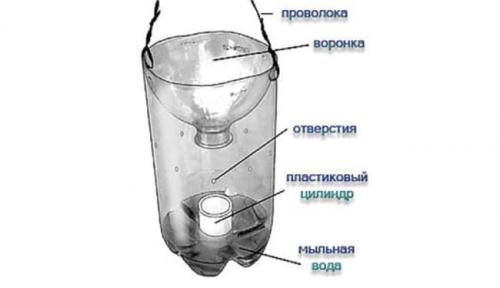

Plastic bottle for catching gristle
The fight against beetle larvae on strawberries begins with the mechanical destruction of detected pests during planting and caring for the crop. When the first grooves are found, they dig up the earth along the bushes to a depth of 40-50 cm. If more than 4 pests are identified, it is necessary to take urgent measures to combat using folk or chemical methods.
It will not be superfluous to collect adult beetles, because any of the females can lay eggs on the strawberry patch. In the early morning they shake off insects from garden plants onto the canvas and destroy them. An effective way to catch May beetles is the construction of light traps:
- Trim the top off of a 5 liter clear plastic container.
- Smear it inside with something sticky (fat, grease, etc.).
- Install a flashlight on the bottom.
- Leave overnight in the place where bugs were seen.
- In the morning, scald the trap with the caught insects with boiling water.
- Repeat the procedure if necessary.
An excellent preventive measure against pests is the autumn deep plowing (digging) of the site. The lower layers of the earth with the larvae rise to the surface during the cultivation of the earth. Birds eat furrows with pleasure, some of the parasites die under the influence of low air temperatures.
Insecticides for the fight against beetles
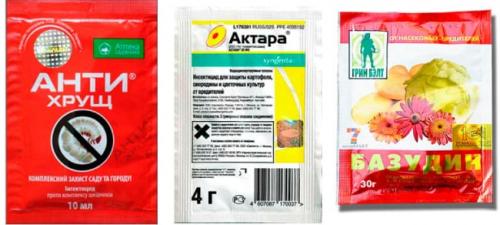

Chemical preparations for crustaceans
With a large accumulation of grooves in the soil, it is necessary to immediately start treating the earth with insecticides. Chemicals are good because the death of pests occurs within a day. The fight against the larva of the May beetle is carried out by one of the following means:
| Name (active substances) | Operating principle | Application |
| Karbofos solution (organophosphorus compound) | Paralyzes the digestive system. |
|
| Antichrusch (imidacloprid, bifenthrin) | Affects the nervous system of the insect. |
|
| Biological product Nemabakt (nematodes infected with a symbiotic bacterium) | Microorganisms settle in the body of the larvae, eat them from the inside. |
|
| Aktara (thiamethoxam) | Intestinal:
|
|
| Bazudin (dazinon) |
|
What harm do beetles do?
The main food of bronzes is flower nectar, and for the larvae - plant residues... But adults can gnaw leaves on flowering ornamental plants and trees, damage young shoots, stamens and pistils on flowers. Beetles eat overripe fruits and berries: mulberries, grapes, raspberries, cherries. The scale of such harm is insignificant, bronzes do not pose a serious threat to the crop and plants... Flowers of ornamental and fruit crops are most often damaged by insects that woke up early from hibernation. Therefore, no special protection measures against bronzes have been developed.
On well-groomed areas, bronzes appear less often. It should be borne in mind that gardens where there are few old, sick and dry trees, rotten stumps are not attractive to an insect.
You will learn more about bronzovki from the video.
The benefits and harms of bronze
In what harm and benefit of the beetle? Bronzovka in the larva stage does no damage. On the contrary, voracious larvae loosen the soil and accelerate the processing of dead plants, contributing to the fertilization of the soil.
It's a different matter - beetle bronzovka. How to deal with it decide, because the insect devours flowers:
- roses
- peony
- phlox
- iris
- fruit and berry plants with light buds
Recommended reading: South African biologist Sidney Brenner was born on January 13, 1927, and received the Nobel Prize for the study of soil microorganisms
Flowers beetles eat, sometimes, together with peduncles, shoots. However, as it was written earlier, only some types of bronzes are dangerous for orchards and vegetable gardens. And they are fighting with them.
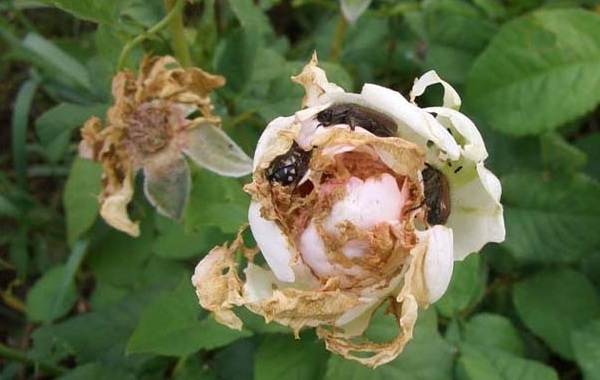

Bronze pests for roses
Interesting facts about the golden beetle
- Despite powerful jaws capable of gnawing a pencil, a beetle bite is not dangerous to humans. He is incapable of causing him serious harm.
- An adult barbel beetle, even of gigantic size, eats very little. Sometimes he lives only thanks to the reserves that he accumulated as a larva. Females feed on more males to ensure normal egg maturation.
- On its territory, the female most often has no rivals. It secretes a special pheromone that attracts males and scares away other females.
- The grown beetle lives one summer season, maximum 2-3 months, and the larva is much larger, for years, in some species up to 10 years.
- Some futurists predict that in the future we will eat wood. If you study and use the digestive system of the barbel beetle, it is quite possible to do this. Its intestines are supplied with special bacteria that convert cellulose into easily digestible carbohydrates.Periodically, the larvae process these bacteria, receiving additional nutrients from them. Waste-free production.
- It may seem strange, but not butterflies and bees, but the barbel beetle is inextricably linked with flowering plants. They spend most of their short life on flowers. And because of their size, they pollinate a large surface. Thanks to his taste preferences, some plants have survived and survived in nature.
Many people think that the metallic sheen of the beetle is due to the presence of a special dye in the structure of the integument of the body, but there is no pigment. A specific copper luster arises from the reflection of light from the wrinkles that cover their body.
There is also an interesting fact about the behavior of the larvae. Sometimes they roll over onto their backs and roll over. In this way, the larvae move, despite the underdevelopment of their limbs.
What kind of food
Nutrition directly depends on the type of insect. The smooth beetle prefers overripe fruits. The specimen does not damage plantings. He is a kind of orderly. Eliminates only bad berries and fruits.
Smelly Bronze feeds on pollen and helps in pollination. Additionally, there are plant roots in the diet, so the beetle is a pest and can destroy plantings in the vegetable garden or in the garden. Bronze of the marble subspecies feeds on rotten wood, namely its juice. Not dangerous for agriculture.
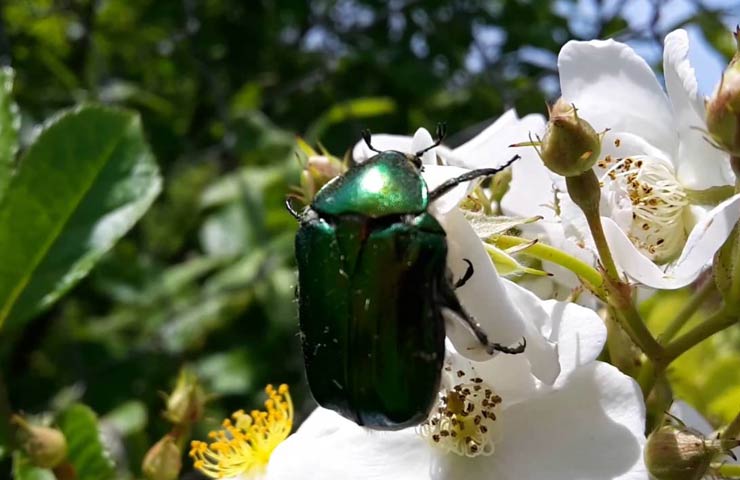

Many types of bronzes feed on pollen.
Bronze in the garden
However, golden bronze is not recognized as a harmful insect. Its larvae are unambiguously useful, pupae are harmless, and damage from adult beetles is insignificant. Experts say that bronzes do not affect the yield of fruit trees. In addition, unlike larvae, adult beetles are not gluttonous and cannot do much harm. Therefore, the fight against bronzes (by manual collection or using chemicals) in most cases does not make sense.
What are the methods of elimination
Chemical treatments are not used as such. The insect flies quickly and the use of solutions will be ineffective. The safest and most effective way is manual processing. Beetles are collected and destroyed on their own. It is permissible to spray the plant in advance with ice water. This will stun the insect.
This video talks about the benefits and dangers of bronzing:
The use of light traps is acceptable. Used at night. To create, you need to put the lamp in a glass container, and next to it is a container with kerosene. The pests will hit the glass and fall into the liquid and die.
Spray the plants with onion tincture. Beetles do not tolerate a strong aroma This will help prevent insect infestations. Additionally, birds should be attracted to the site, which destroy bronzers.
Is it possible to fight
For a long time, there were no insect control methods. This is due to the fact that the gardeners were confident in the complete harmlessness of the beetle. This opinion is wrong. Some subspecies are not averse to being fed by fruit trees and shrubs, as well as ornamental plants.
The fight should start from the larval stage. This processing will be most effective. Rotten trees and stumps and leaves should be removed regularly. This will make it possible to reduce the number of individuals on the site.
What are the features of reproduction and life cycle
For reproduction, the female lays eggs. The color of the shell is white-yellow. Each female produces up to 20 beetles at a time. Clutches of eggs are found in rotten trees. It is also possible to find young offspring in the trunks and manure. It takes about a year before the first larvae appear. In the absence of favorable conditions, the term can last up to 3 years.
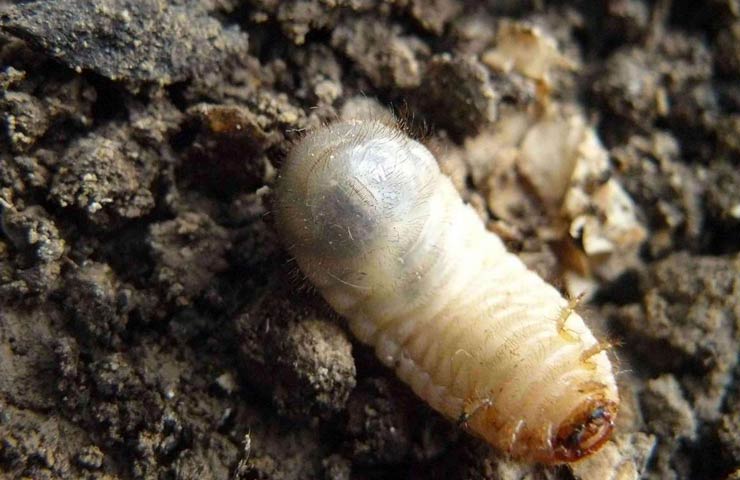

The beetle grows out of the larva
Beetle larvae prefer leaves as food, less often - trees and plant roots. Caterpillars have a curved body. The legs are short. The body is thick and hairy. The back is widened.
The larva reaches 7 cm in length. After maturation, pupation occurs. The cocoon is strong and oval in shape. Consists of soil, excrement and wood. The gluing of all components is carried out due to the release of a specific substance from the legs.
The pupa resembles a beetle in appearance. Pupation lasts several weeks. After that, a full-fledged beetle is born.

